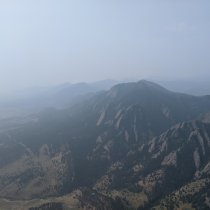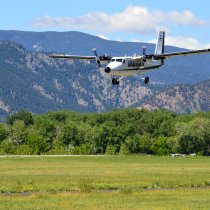Data Notification
NEON Remote Sensing Data Available on Google Earth Engine
September 16, 2024
NEON has added a subset of the Airborne Observation Platform (AOP) (NEON Airborne Remote Sensing) data products to Google Earth Engine (GEE), an optimized cloud-computing platform for conducting remote sensing data analysis. GEE is free for research purposes (non-commercial use). Data on GEE will provide another avenue through which researchers can access and work with AOP data; all AOP data products can still be accessed as usual through the NEON Data Portal.
The AOP datasets are now searchable and findable on the GEE Publisher Data Catalogs. All AOP datasets can be seen here, or if you search for "NEON" in the Earth Engine Data Catalog or through the code editor search bar.
AOP data products that are being added as Image Collections in GEE are summarized in the table below:
| Data Product Name (with link to product webpage) | GEE Asset | NEON Data Product Number |
|---|---|---|
| Spectrometer orthorectified surface bidirectional reflectance - mosaic | HSI_REFL/002 | NEON.DOM.SITE.DP3.30006.002 |
| Spectrometer orthorectified surface directional reflectance - mosaic | HSI_REFL/001 | NEON.DOM.SITE.DP3.30006.001 |
| High-resolution orthorectified camera imagery mosaic | RGB/001 | NEON.DOM.SITE.DP3.30010.001 |
| Ecosystem Structure (Canopy Height Model) | CHM/001 | NEON.DOM.SITE.DP3.30015.001 |
| Elevation - LiDAR (Digital Terrain Model + Digital Surface Model) | DEM/001 | NEON.DOM.SITE.DP3.30024.001 |
Reading AOP data into GEE and determining data availability:
These AOP Image Collections can be read in from the Earth Engine code editor as follows (select the desired GEE asset name, e.g., 'CHM/001` to read in each dataset).
var CHM = ee.ImageCollection('projects/neon-prod-earthengine/assets/CHM/001')
To see the available datasets in each collection, you can run the following print statement:
print('NEON Images in the CHM Collection',
CHM.aggregate_array('system:index'))
Resources for working with AOP data in GEE:
To get started working with AOP data in GEE, please refer to the self-paced Intro to AOP Data in Google Earth Engine Tutorial Series (which also includes instructions for registering for GEE). These educational resources use the GEE code editor, in the JavaScript programming language. There are also Python API bindings for working with Earth Engine. You can find an introductory lesson on working with AOP data in GEE using Python and the geemap package here. These linked tutorials demonstrate how to read in the AOP data and access relevant metadata information, such as the Release of the data (see Data Product Revisions and Releases), and QA information crucial to interpreting the data.
Current availability and requesting data additions:
Data currently available on GEE represent a small portion of the full archive of sites and years of AOP data available. We will be progressively adding the entire archive for the data products listed above. If your NEON site of interest is not currently included in the GEE catalog, you can request to add NEON sites and years and we will prioritize these sites for earlier addition. Please use NEON’s Contact Us form to request data additions to GEE, and include the term "Google Earth Engine" in the body of your request.
A note on bidirectional v. directional reflectance data:
AOP is now implementing BRDF (Bidirectional Reflectance Distribution Function) and topographic corrections to the reflectance data, which helps even out the effects of variable illumination and viewing geometries during data collection. We have added a small number of these bidirectional datasets to GEE (HSI_REFL/002), provisionally, starting with data collected in 2022. Eventually we will only deliver BRDF-corrected reflectance data on GEE, but until this corrected data is available, we can provide the Surface Directional Reflectance data (HSI_REFL/001) upon request. For more information on the differences between the directional and bidirectional reflectance datasets, please refer to this tutorial.
Questions?
If you have any general questions about AOP data in Google Earth Engine, or would like an update on NEON's plans around this effort, please fill out NEON’s Contact Us request form.

